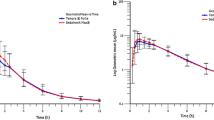Summary
The absorption, biotransformation and elimination of the anticoagulant acenocoumarol, 3-[α- (4′-nitrophenyl)-β-acetylethyl]-4-hydroxycoumarin, have been studied by oral administration of 12 mg of a14C-labelled preparation to two male volunteers. Absorption from the gastro-intestinal tract was rapid and the plasma concentration of unchanged drug reached a maximum of 169 and 412 ng/ml, respectively, after 3 hours. The elimination half-life in the two subjects, calculated from the decline between 6 and 24 h, was 8.7 and 8.2 hours. A constant proportion of 98.7% of the drug was bound in vitro to serum proteins over a concentration range of 0.021–8.34 µg/ml, with little interindividual variation. The major portion of the binding was to human serum albumin (97.5%) at two classes of binding sites: association constant K1=1.04×105 l/mole (n1=1) and K2=5.55×103 l/mole (n2=4). In addition to unchanged acenocoumarol, four metabolites were determined in plasma by isotope dilution techniques: the amino-, acetamido-, alcohol1- and alcohol2-metabolites. Of them, the amino-metabolite showed the highest concentration, namely 278 ng/ml, after 6 h in Subject A, and 163 ng/ml after 10 hours in Subject B. Judged from the integrated concentrations, the compounds analyzed accounted for 76 and 89%, respectively, of the total radioactivity in plasma. All the metabolites detected in plasma showed anticoagulant activity when tested in mice. The quantities of the metabolites excreted in urine from 0–120 hours were (Subject A/Subject B): acenocoumarol 0.3/0.2%, amino-metabolite 12.3/7.7%, acetamido-metabolite 19.0/11.1%, alcohol1-metabolite 4.6/9.0%, alcohol2-metabolite 1.7/4.4%, 6-hydroxy-metabolite 6.9/18.3% and 7-hydroxy-metabolite 14.0/22.2%.
Similar content being viewed by others
References
Renk, E., Stoll, W.G.: Orale Antikoagulantien. In: Fortschr. Arzneim. Forschg. (ed. E. Jucker) Vol.11, 226–355. Basel und Stuttgart: Birkhäuser 1968
Blatrix, C., Charonnat, S., Tillement, J.P., Israel, J., Brevet, J.P., Debraux, J., Merlin, M.: Métabolisme chez l'homme du dérivé de la 4-hydroxycoumarine: 3(α-acétonyl-p-nitrobenzyl)4-hydroxy-coumarine (Sintrom). Rev. Franç. Etudes Clin. Biol.13, 984–995 (1968)
Dieterle, W., Faigle, J.W., Mory, H., Richter, W.J., Theobald, W.: Biotransformation and Pharmacokinetics of sulfinpyrazone (Anturan®) in Man. Europ. J. clin. Pharmacol.9, 135–145 (1975)
Schmid, K., Riess, W., Egger, H.P., Keberle, H.: In: International Conference on Radioactive Isotopes in Pharmacology (eds. P.G. Waser, B. Glasson), pp. 67–82. London, New York: Wiley 1969
Sie, S.T., van den Hoed, N.: Preparation and performance of high-efficiency columns for liquid chromatography. J. Chromatogr. Sci.,7, 257–266 (1969)
Chan, K.K., Lewis, R.J., Trager, W.F.: Absolute configuration of the four warfarin alcohols. J. med. Chem.15, 1265–1270 (1972)
Montigel, C., Pulver, R.: Die Bestimmung der Prothrombinzeit mit der Thrombokinase “Geigy” (G 23 787). Schweiz. med. Wschr.82, 132–135 (1952)
Dieterle, W., Wagner, J., Faigle, J.W.: Binding of chlorthalidone (Hygroton®) to blood components in man. Europ. J. clin. Pharmacol.10, 37–42 (1976)
Scatchard, G.: The attraction of proteins for small molecules and ions. Ann. N.Y. Acad. Sci.51, 660–672 (1949)
Fletscher, J.E., Spector, A.A.: A procedure for computer analysis of data from macromolecule-ligand binding studies. Comp. Biomed. Res.2, 164–175 (1968)
Garten, S., Wosilait, W.D.: An analysis of the binding of coumarin anticoagulants by human serum albumin. Comp. gen. Pharmac.3, 83–88 (1972)
Tillement, J.-P., Zini, R., Mattei, C., Singlas, E.: Effect of phenylbutazone on the binding of vitamin K antagonists to albumin. Europ. J. clin. Pharmacol.6, 15–18 (1973)
Tillement, J.-P., Zini, R., d'Athis, P., Vassent, G.: Binding of certain acidic drugs to human albumin: theoretical and practical estimation of fundamental parameters. Europ. J. clin. Pharmacol.7, 307–313 (1974)
Barker, W.M., Hermodson, M.A., Link, K.P.: The metabolism of 4-C414-warfarin sodium by the rat. J. Pharmacol. exp. Ther.171, 307–313 (1970)
Lewis, R.J., Trager, W.F.: The metabolic fate of warfarin: studies on the metabolism in plasma. Ann. N. Y. Acad. Sci.179, 205–212 (1971)
Deckert, F.W.: Warfarin metabolism in the guinea pig I. Pharmacological studies. Drug Met. Dispos.1, 704–710 (1973)
Lewis, R.J., Trager, W.F., Robinson, A.J., Chan, K.K.: Warfarin metabolites: the anticoagulant activity and pharmacology of warfarin alcohols. J. Lab. clin. Med.81, 925–931 (1973)
Rieder, J.: Methoden zur Bestimmung von 1,3-dihydro-7-nitro-5-phenyl-2H-1,4-benzodiazepin-2-on und seinen Hauptmetaboliten in biologischen Proben und Ergebnisse von Versuchen über die Pharmakokinetik und den Metabolismus dieser Substanz bei Mensch und Ratte. Arzneim.-Forsch. (Drug Res.)15, 1134–1148 (1965)
Cox, P.L., Heotis, J.P., Polin, D., Rose, G.M.: Quantitative determination of dantrolene sodium and its metabolites by differential pulse polarography. J. Pharm. Sci.58, 987–989 (1969)
Eschendorf, E.: Untersuchung über das Schicksal des Antikonvulsivums Clonazepam im Organismus der Ratte, des Hundes und des Menschen. Arzneim.-Forsch. (Drug Res.)23, 390–400 (1973)
Woolhouse, N.M., Kaye, B., Monro, A.M., Parke, D.V.: The metabolism of 5,7-dinitroindazole in the mouse and the rat. Xenobiotica3, 511–524 (1973)
Yanagi, Y., Haga, F., Endo, M., Kitagawa, S.: Comparative metabolic study of nimetazepam and its desmethyl derivative (nitrazepam) in rats. Xenobiotica5, 245–257 (1975)
Connors, T.A., Hickman, J.A., Jarman, M., Melzack, D.H., Ross, W.C.J.: The metabolism of the anti-tumour agent 1 (1-aziridinyl)-2,4-dinitrobenzene (CB 1837). Biochem. Pharmacol.24, 1665–1670 (1975)
Trager, W.F., Lewis, R.J., Garland, W.A.: Mass spectral analysis in the identification of human metabolites of warfarin. J. med. Chem.13, 1196–1204 (1970)
Lewis, R.J., Trager, W.F.: Warfarin metabolism in man: identification of metabolites in urine. J. clin. Invest.49, 907–913 (1970)
Burns, J.J., Weiner, M., Simson, G., Brodie, B.B.: The biotransformation of ethylbiscoumacetate (Tromexan) in man, rabbit and dog. J. Pharmacol. exp. Ther.108, 33–41 (1953)
Shilling, W.H., Crampton, R.F., Longland, R.C.: Metabolism of coumarin in man. Nature221, 664–665 (1969)
Author information
Authors and Affiliations
Rights and permissions
About this article
Cite this article
Dieterle, W., Faigle, J.W., Montigel, C. et al. Biotransformation and pharmacokinetics of acenocoumarol (Sintrom®) in man. Eur J Clin Pharmacol 11, 367–375 (1977). https://doi.org/10.1007/BF00566534
Received:
Revised:
Issue Date:
DOI: https://doi.org/10.1007/BF00566534




